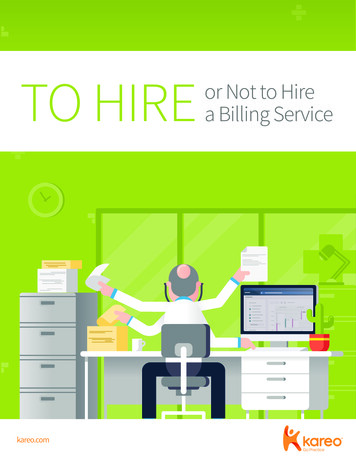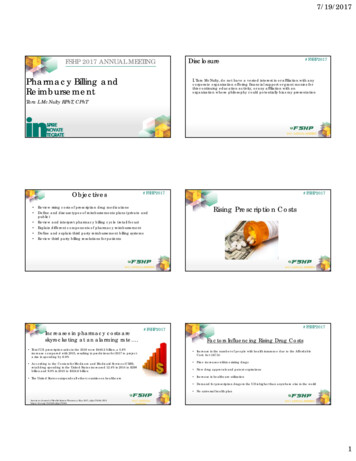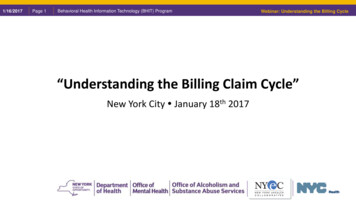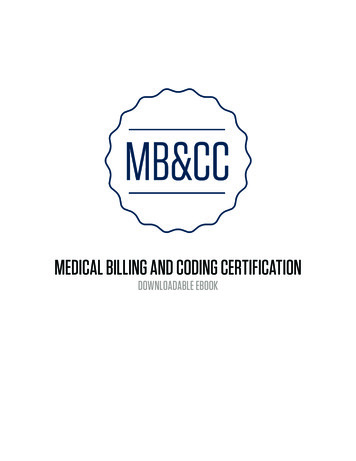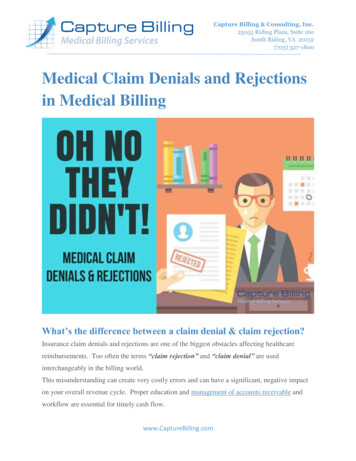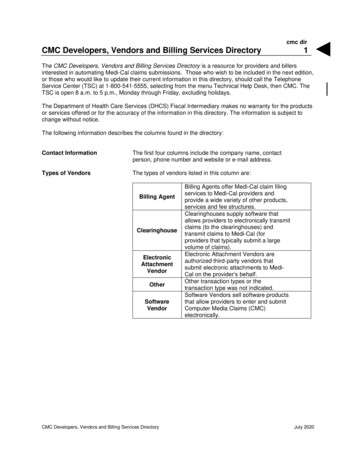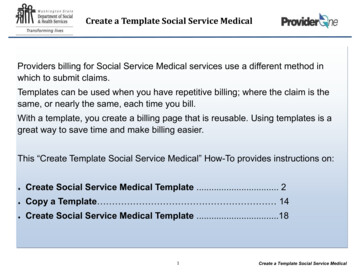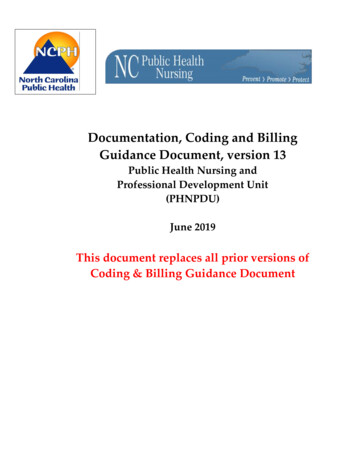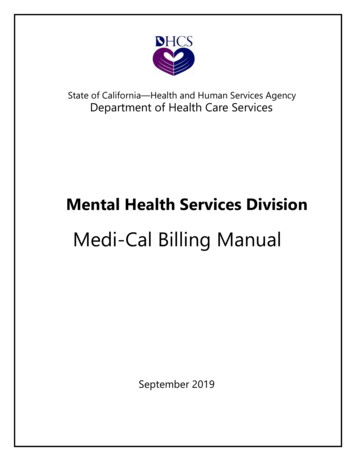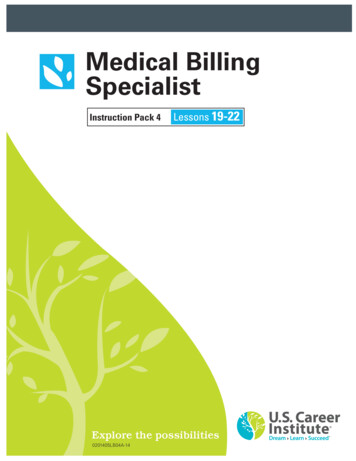
Transcription
Medical BillingSpecialistInstruction Pack 4Lessons 19-22Explore the possibilities0201405LB04A-14
MedicalBillingSpecialistInstruction Pack 4Lesson 19—Secondary ClaimsLesson 20—The UB-04 Claim FormLesson 21—Medical Billing TechnologyLesson 22—The Future of Health Care
No part of this document may be reproduced or transmitted in any form or by any means, electronic ormechanical, for any purpose, without the express written permission of U.S. Career Institute.Copyright 2013, Weston Distance Learning, Inc. All Rights Reserved.0201405LB04A-14AcknowledgmentsAuthorsKaty LittleBrenda BlombergEditorial StaffTrish BowenKimberly FieldsKathy DeVaultKelly BrownJoyce JeckewiczStephanie MacLeodCarrie WilliamsDesign/LayoutConnie HunsaderSandy PetersenD. Brent HausemanU.S. Career InstituteFort Collins, CO 80525www.uscareerinstitute.edu
Table of ContentsLesson 19: Secondary ClaimsStep 1: Learning Objectives for Lesson 19 . 1Step 2: Lesson Preview . 1Step 3: Coordination of Benefits . 1Employee, Member or Subscriber . 2Dependent Children of Parents Not Separated or Divorced . 2Dependent Children of Parents Separated or Divorced . 2Step 4: Practice Exercise 19-1 . 3Step 5: Review Practice Exercise 19-1 . 3Step 6: Processing a Claim for a Secondary Payer . 3Automatic Crossover . 3Secondary Claims . 4Step 8: Practice Exercise 19-2 . 8Step 9: Review Practice Exercise 19-2 . 10Step 10: Practice Exercise 19-3 . 10Step 11: Review Practice Exercise 19-3. 12Step 12: Lesson Summary. 12Endnotes . 12Lesson 20: The UB-04 Claim FormStep 1: Learning Objectives for Lesson 20 . 1Step 2: Lesson Preview . 1Step 3: Introduction to Inpatient Billing . 1Step 4: UB-04 Form Locators. 4Step 5: Practice Exercise 20-1 . 11Step 6: Review Practice Exercise 20-1 . 12Step 7: Understanding the UB-04 Claim Form . 120201405LB04A-14III
Medical Billing SpecialistStep 8: Practice Exercise 20-2 . 14Step 9: Review Practice Exercise 20-2 . 16Step 10: Lesson Summary. 16Step 11: Quiz 18 . 16Lesson 21: Medical Billing TechnologyStep 1: Learning Objectives for Lesson 21 . 1Step 2: Lesson Preview . 1Step 3: Clearinghouse and Electronic Claims Submission . 2Why Submit Electronically? . 3Electronic Transactions Save Money . 3Claim Submission Routes . 4Step 4: Practice Exercise 21-1 . 4Step 5: Review Practice Exercise 21-1 . 5Step 6: MedLook . 5MedLook Installation . 6Getting Started . 7Step 7: Databases . 8Provider. 10Facilities . 13Referral Sources . 15Insurance Carriers . 16Procedure Codes. 20Diagnosis Codes . 21Deleting . 22Step 8: Practice Exercise 21-2 . 23Step 9: Review Practice Exercise 21-2 . 24Step 10: Patient Accounts . 24Patient Account—Edit . 25Patient Account—Summary . 33Step 11: Practice Exercise 21-3 . 34Step 12: Review Practice Exercise 21-3. 35IV0201405LB04A-14
Table of ContentsStep 13: Patient Account—Charge . 35Policies . 36Prior Authorizations/CLIA . 37Diagnosis Codes . 38Parameters . 38Patient Condition Related To . 38Miscellaneous Items . 39Hospitalization . 40Illness. 40Disability . 40Enter Charge. 41Step 14: Patient Account—Transactions . 42Step 15: Patient Account—Billing . 43Step 16: Practice Exercise 21-4 . 47Step 17: Review Practice Exercise 21-4. 48Step 18: Lesson Summary. 48Step 19: Quiz 19 . 49Lesson 22: The Future of Health CareStep 1: Learning Objectives for Lesson 22 . 1Step 2: Lesson Preview . 1Step 3: Technology and Health Care: Today . 1Step 4: Electronic Health Records . 3Step 5: Access the Internet and the Web from a Computer . 5The Computer Network. 6Step 6: Electronic Coding . 8Encoder Programs . 8Computer-assisted Coding . 10Step 7: Web-based Medical Records . 11Step 8: Practice Exercise 22-1 . 12Step 9: Review Practice Exercise 22-1 . 12Step 10: Lesson Summary. 12Step 11: Quiz 20 . 12Endnotes . 120201405LB04A-14V
Medical Billing SpecialistAnswer KeyLesson 19 . 1Practice Exercise 19-1 . 1Practice Exercise 19-2 . 2Practice Exercise 19-3 . 4Lesson 20 . 6Practice Exercise 20-1 . 6Practice Exercise 20-2 . 6Lesson 21 . 7Practice Exercise 21-1 . 7Practice Exercise 21-2 . 7Practice Exercise 21-3 . 14Practice Exercise 21-4 . 18Lesson 22 . 20Practice Exercise 22-1 . 20VI0201405LB04A-14
Lesson 19Secondary ClaimsStep 1: Learning Objectives for Lesson 19When you complete the instruction in this lesson, you will be trained to: Describe the process of coordination of benefits and define terminology involved. Explain and demonstrate the process of completing a claim for the secondary carrier.Step 2: Lesson PreviewAt this point, you’re familiar with completing claim forms for primary health insurance carriers, and youcan review EOBs, as well. Now, it’s time to go a step further and learn how to complete secondary claims forpatients who have more than one healthcare plan. Let’s start by looking at an example.Kayla Marshall comes in with her mother, Darci Rogers, due to a rash on Kayla’s leg. Kayla’s parents aredivorced and each has insurance coverage for Kayla. How will you determine which insurance is the primarycarrier and which is secondary?Once you determine the primary carrier, you’ll complete and submit the CMS-1500 claim form. You’llreceive the EOB and interpret the payment, write off and amount due. Now, what do you do if there is asecondary payer? What does the secondary claim look like?This lesson will answer all of these questions and more. You’ve learned about the birthday rule, but nowyou’ll discover the details of primary and secondary carriers, along with the associated terminology you’llneed to know. Then, you’ll review the original claim form and EOB in order to create a secondary claim. Thedifferences are in the details, so be sure to examine claims carefully for a firm understanding of this process.Step 3: Coordination of BenefitsAs you know, some patients have coverage under more than one insurance policy. Coordination of benefits(COB) applies to a person who has coverage under more than one health plan. The COB provision andregulations require that all health plans coordinate benefits to eliminate duplication of payments, andto assist patients in receiving the maximum benefits to which they are entitled. By adhering to the COBprovisions, payers can accurately determine which plan will pay for a claim first. As you recall, the insurancecompany obligated to pay a claim first is called the primary payer, and the other payer is secondary. Together,the primary and secondary payers coordinate payments for services up to 100 percent of the covered chargesat a rate consistent with the benefits plan.
Medical Billing SpecialistAs a medical billing specialist, it’s not up to you to determine coverage. However, understanding the generalrules will help you assist patients with the billing process. Let’s take a closer look at the general rules fordistinguishing primary payers from secondary payers for adults and children.Employee, Member or SubscriberFirst, the plan that covers an individual as an employee, member or subscriber is primary over the plan thatcovers the individual as a dependent.For example, Dan and Rebecca are married, and they both have insurance coverage through their employers.Dan has Health Services Inc., while Rebecca is insured through Mountain States. Each plan includesdependents; therefore, Health Services Inc. is Dan’s primary payer and Mountain States is his secondary payer.On the other hand, Rebecca has Mountain States as primary and Health Services Inc. as secondary insurance.Dependent Children of Parents Not Separated or DivorcedDependent children of parents who are married may fall under the birthday or gender rule. You are aware ofthe birthday rule—the plan covering the parent whose birthday falls earlier in the year is the primary carrier.However, some plans follow the Gender Rule, which indicates that the father’s coverage is the primarycarrier. As mentioned previously, you won’t determine the primary and secondary payer in your billing role,but this basic knowledge will help you understand the overall billing process in general.For instance, Dan and Rebecca have two children, both of whom have coverage under Health Services Inc. andMountain States. The state law where they live indicates that the birthday rule will determine coverage. Dan’sbirthday is July 1st and Rebecca’s is December 29th. Because Dan’s birthday falls earlier in the year, HealthServices Inc. is the primary payer and Mountain States is the secondary payer for their children’s coverage.Dependent Children of Parents Separated or DivorcedAccording to the American Medical Association, “Seeking payment for services provided to dependentchildren of divorced or separated parents can raise COB issues. States may take different approachesconcerning what, if any, COB rules apply when a practice seeks payment for services provided to dependentchildren of divorced or separated couples.”1Insurance plans must pay in the order below if dependent children are covered by more than one payer andthe parents are separated or divorced:1. The plan of the parent with custody of the child2. The plan of the spouse of the parent with custody of the child3. The plan of the parent who does not have custody of the childHowever, if the terms of a court decree state that one parent is responsible for the healthcare expenses of thechild and the insurance company has been advised of the responsibility, that plan is the primary carrier overthe plan of the other parent.Usually, the parents know the order of insurance payers and will provide that information so the claim can becompleted accurately.19-20201405LB04A-19-14
Secondary ClaimsNow, let’s go back to the example. Kayla Marshall comes in with her mother, Darci Rogers, due to a rashon Kayla’s leg. Kayla’s parents are divorced and each has insurance coverage for Kayla. The new patientquestionnaire indicates Eric Marshall is the policy holder on the primary insurance, Blue Cross of Colorado;Darci Rogers is the policy holder on the secondary insurance, TRICARE.You’ve completed the CMS-1500 claim form for the primary payer and now know the process for the COB.In this lesson, you’ll also learn how the secondary payer’s CMS-1500 claim form differs. But first, let’s pauseto complete the following Practice Exercise.Step 4: Practice Exercise 19-1Answer each item as directed, and write your answers on scratch paper.1. Bobby lives with his mother and stepfather. Bobby’s mother’s health plan is with Windy CityBenefits. Bobby’s father’s health plan is with Rocky Road Health. His stepfather’s health planis with Health Benefits of Northern Colorado. What is the order of the payer coverage?2. Sally’s parents are Mark and Grace. Since both Mark and Grace have family insurancebenefits, you will have to use the birthday rule to determine Sally’s primary and secondarypolicies. Mark’s birthday is July 10, 1968, and Grace’s birthday is September 5, 1967. Whichis the primary payer and why?3. Mark and Grace have divorced, and Grace has custody of Sally; however, the court decreeindicates that Mark is responsible for Sally’s healthcare expenses. Which is the primarypayer and why?Step 5: Review Practice Exercise 19-1Check your answers with the Answer Key at the back of this book. Correct any mistakes you may have made.Step 6: Processing a Claim for a Secondary PayerSo far, you’ve discovered the process of completing a claim for a primary payer and explored the variety ofEOBs, learning how to interpret them along the way. Now, you’re ready for the next step, which is submittinga claim to the secondary payer. You can do this by using an automatic crossover, sending an electronic claimor submitting a paper claim. In each case, the secondary carrier needs to know what the primary carrier paidon the claim in order to coordinate benefits.Automatic CrossoverIf the plan has an automatic crossover, it’s not necessary to submit a claim to the secondary insurance. In anautomatic crossover, the primary carrier handles the coordination of benefits transaction by sending thesecondary carrier the primary claim information electronically.0201405LB04A-19-1419-3
Medical Billing SpecialistYou’ll see this most often with Medicare claims that have supplemental insurance. Recall that field 9a of theCMS-1500 claim form requires a PAYERID for Medicare claims. A PAYERID is a unique, eight-digit numberassigned to each healthcare payer; it is used in electronic claims to route the secondary claim automatically.For example, Joshua has Medicare as his primary insurance and Rocky Mountain Insurance as hissupplemental coverage. When Joshua’s provider submits a claim to Medicare, Medicare pays its portion ofthe claim and then forwards the claim information to Rocky Mountain Insurance. Then, that company canprocess its own portion of the claim.For a patient with Medicare and Medicaid, the claim will be filed to Medicare as the primary carrier.Medicare will pay the claim, apply a deductible or copayment amount and then automatically forward theclaim to Medicaid. The Medicare RA will have an indicator that shows the claim was an automatic crossoverto Medicaid, so you’ll know not to submit a duplicate claim to Medicaid.Secondary ClaimsAt one time, to submit a claim to the secondary payer, you would only have the option of submitting the claimby mail. In addition to the claim, you’d send a copy of the primary payer’s EOB to show the reimbursementamount. You would then mail the claim with a copy of the EOB to the secondary carrier for payment.19-40201405LB04A-19-14
Secondary ClaimsWith electronic claims submission, many insurance carriers use automatic crossover, which means that youdon’t have to submit a secondary claim. The claim will be forwarded to the secondary payer, and the amountpaid is provided, as well.0201405LB04A-19-1419-5
Medical Billing SpecialistOn the other hand, you may find that some carriers don’t accept automatic crossovers, but will acceptelectronic submissions without a copy of the primary EOB.Participating healthcare plans will not require providers to submit paper EOBs withelectronic secondary claims, as long as the primary payer is a commercial insurancecompany (not Medicare) and the necessary EOB information is included with the claim.Reference: Group Health Cooperative, at https://provider.ghc.org/open/render.jhtml?item ondary.xmlThis lesson focuses on submitting paper claims. You will learn more about electronic claims later in thiscourse. You will explore the general standards for completing secondary claims, but it is always a good ideato contact the carrier to verify specifics when you’re working as a medical billing specialist.When submitting a paper claim, you’ll complete the CMS-1500 form with the secondary payer in the CarrierAddress area, and then move the primary insured’s information to where the secondary information isusually listed and the secondary insured’s information on the right side of the claim.Let’s compare claims for primary and secondary payers.Primary Payer Address Primary Insured’s Information Secondary Insured’s Information 19-60201405LB04A-19-14
Secondary ClaimsSecondary Payer Address Secondary Insured’s Information Primary Insured’s Information Note: Physician & Supplier Section Does Not Change Essentially, the primary and secondary payers switch places when you submit the claim to the secondarypayer for reimbursement. Let’s examine the specifics.The original claim form for Brandon Niles was mailed to Net Life, as it’s listed in the Carrier Section. You’llsee that Gary T. Niles is listed in the primary insured area on the right (fields 1a, 4, 7, 11, 11a and 11c), whileTheresa is in the secondary area (fields 9, 9a and 9d).Now, look at the secondary claim form for Brandon Niles. This time, you’ll submit the bill to the secondaryinsurance, which is Blue Cross of Colorado. Look at the Carrier Section of the secondary claim form. Do yousee that the address is no longer for Net Life? What else has changed on the secondary claim? You shouldsee that Theresa’s insurance information has moved to the right side of the claim, while Gary’s insuranceinformation is now in fields 9, 9a and 9d.Field 29 may also reflect any payments received.Does that make sense? You’ll have a chance to reinforce your understanding with the upcomingPractice Exercise. First, you’ll complete a claim for the primary payer. Then, you’ll review the EOBfrom the primary payer. Finally, you’ll complete a claim for the secondary payer. This process may seemunnecessary, and you may want to skip it and move on in your studies—but the details are important!Understanding this process is essential to success in the medical billing profession. Be sure to participatein each step to ma
Mark and Grace have divorced, and Grace has custody of Sally; however, the court decree indicates that Mark is responsible for Sally’s healthcare expenses. Which is the primary payer and why? Step 5: Review Practice Exercise 19-1 Check your answers with the Answer Key at the b

